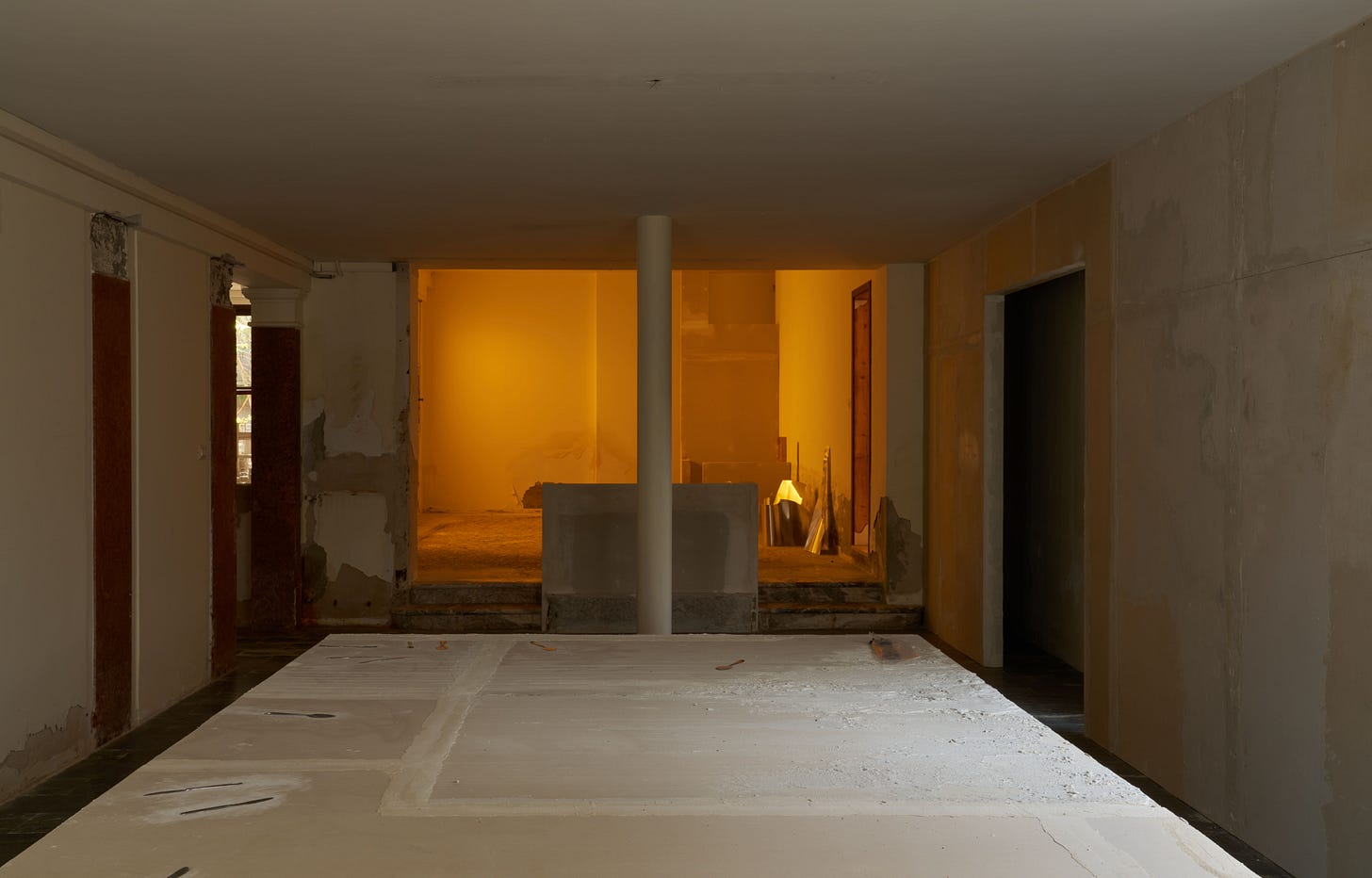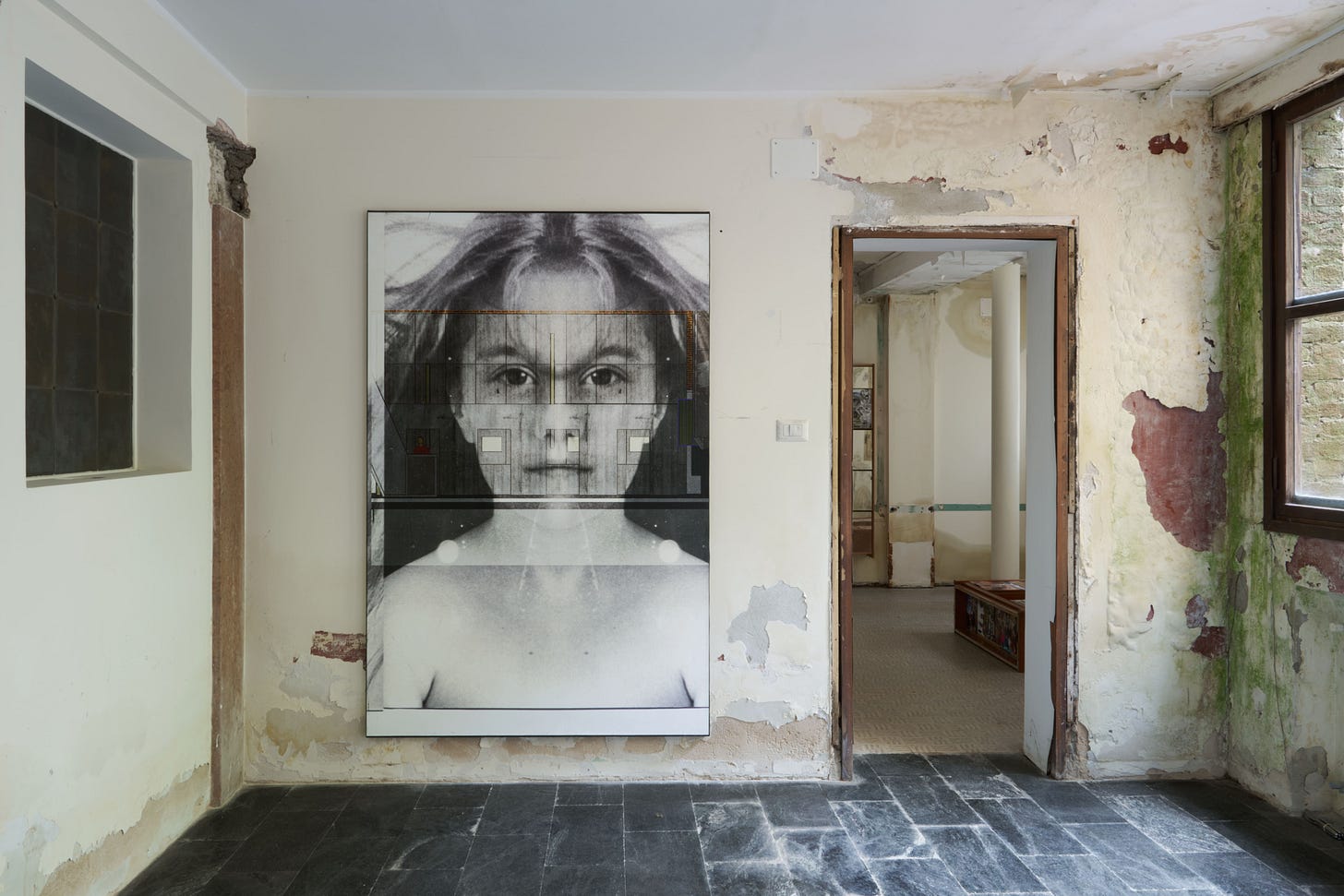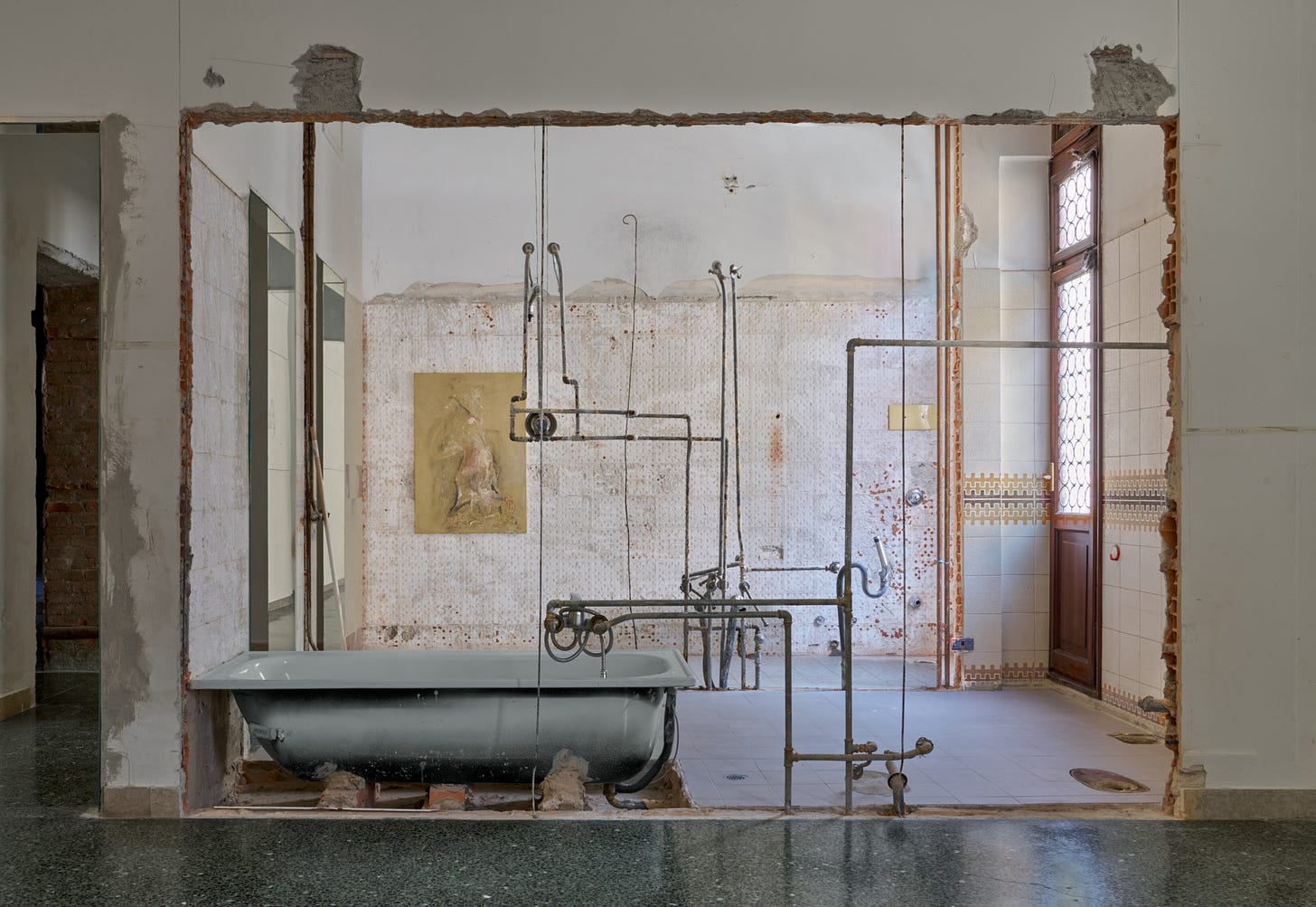A Knock On the Door: Tolia Astakhishvili at Nicoletta Fiorucci Foundation
The London-based Nicoletta Fiorucci Foundation opened a new outpost in Venice and its first show is a slow burn worth the wait.
A Dirty Little Secret
Although located right at Fondamenta Gherardini — a couple of steps from the spot at Campo San Barnaba where Indiana Jones famously spawned out of a drain cover — it wasn’t easy to find the place. There’s no signage. It’s hard to stumble in by chance. Even if you peek a look inside, you don’t see anything alluding to an exhibition set up. You must know where you’re going, or else you’ll miss it. I’m surprised that the foundation keeps it so secretive (or maybe it’s just plain gatekeeping), considering that art world Godfather Hans Ulrich Obrist (Gen X, Swiss) curated the show.
As I get in, I give my eyes a moment to adjust to the light situation. The windows facing the canal are covered with opaque veils and rich amber acrylic paint. The windows facing the courtyard are covered with old newspapers as if preparing the site for construction work. It reminds me also of how, traditionally, artists would cover their studio windows for softer lighting. I see smudged, undecipherable writing and a tic-tac-toe. It’s barely visible, effortless and gentle like a child’s finger-painted heart on a foggy bus window.

Those traces must be Tolia Astakhishvili’s (Gen X, Georgian). According to the press release, she spent the first months of this year in this peculiar building: A two-story fifteenth-century palazzo that once was a church-run orphanage, deteriorated and went through several hands, got confiscated by Napoleon, was requested to become a devotional place (but didn’t end up becoming one). It went through major remakes and alterations in 1924 as the artist Ettore Tito’s (1859-1941, Italian) residence and studio, in 1937 under architect Angelo Scattolin (1904-1981, Italian), and in 1973 as property of the Cassa Marittima Adriatica (shout out to the press kit for including the research and receipts).
Tolia took it upon herself to respond to the run-down space as it is before it gets a glow-up for the future program and invited 8 other artists to come along.

Walking Into A Construction Site
Keeping that historical back-and-forth in mind, the space becomes even more intriguing. According to Hans Ulrich’s introductory text, Tolia has often worked with fragmentation and construction. But those projects were “artificial construction sites”. Here, the construction site is the groundwork. What did Tolia & Co. change (and according to the press text, they sure did change stuff)? Which walls were torn for this show and which in the decades before? What did Tolia already find exposed upon her arrival, and what did she shed light on? Is what I see “natural” deterioration or artistic addition?
A rectangular, concrete-looking plaster chunk the size of a table obstructs the first larger room close to the window. Was this the dining room once? The piece is called taste (snoring and the sound of pigeons) (2025). Cutlery is inlayed into custom moulds, keeping the surface flat. It also includes a sound piece by Dylan Peirce (Gen X, British), which I either don’t remember or didn’t hear because of everything going on.
Exposed pipes and plaster walls, along with marble columns, catch my eye. I walk into a small cubicle the size of a storeroom. That fat fruit fly speeding out and bumping into me must have been a paid actor. Mini-architecture models take up space as drawings and objects on top of other works. One blank model hosts water and wine glasses instead of people, while alluding to the remains of a joyful get-together. I stop at a wall telephone surrounded by delicate drawings and photographs of messy interiors. There’s some lines written next to the phone, always with the time 11:24 and a short phrase underneath. It’s as if someone was so absorbed in a call that they scribbled their notes right on the wall. But the unchanging time suggests a chat history. If only there was a way to know if those are a conversational back and forth or unanswered double texts.

Tolia made I can’t imagine how I can die if I am so alive (2025) together with her father, Zurab Astakhishvili, who (according to other sources) isn’t actually an artist. The work consists of four wooden furniture pieces covered in collage. Now, if there’s one thing about me, it’s that I’m immediately gagged when there’s a collage situation going on. There’s a lot of models and animals, but as I read in the booklet of the Bonner Kunstverein, it’s also family and friends. Collage is such an at-home material. I wonder what was at the forefront: The work or the time spent together doing it? One collage on a glass cabinet is made up of two main parts, a blonde woman whose bang covers her eyes, and a slit right above: attentive green eyes with sharp eyeliner. Shark teeth cover the original mouth, emphasizing the animalistic gaze (not in an erotic way) of that newly constructed woman.
Heike Gallmeier’s (Gen X, German) large-scale print Prospective Dream (2010) is positioned in a corridor so narrow that I can’t stand in front of it, but only see it fully from the side, standing behind the doorframe. It looks as if she collaged the pictures of architecture into a chaotically assembled room and emphasized some parts through paint. A female head peeks out of a wooden-plank-waved-metal-sheet-no-pillow-bed. Something about that composition reminds me of a Renaissance interior. I think it’s also because of the colors. Something like a deathbed or a birth scene that I remember seeing at Galleria dell’Accademia here in Venice. And I’m pretty sure I found the 1 to 1 inspiration for Heike’s piece, which seems to be Carpaccio’s Dream of Saint Ursula (1495).
Upstairs, entire walls are cut out to reveal the pipes of a bathroom system. The pipes become a wall themselves, all neatly lined in one row. Something hidden behind concrete, bricks, or plaster once is now not behind a space but within that space. I enjoy the quirky 70s tiles Tolia kept as well as the bumpy texture of the wall where they were removed. I almost missed the cream colored paneled wall on the other side, where breathy brushstrokes form a head looking to an elusive green patch somewhere in the suggested distance of the flat void.

My favorite piece was I love seeing myself through the eyes of others (2025). It’s a huge opaque cube lit from within in an otherwise completely dark room. I see leafy branches snuggling up against the walls. I can make out some shelves, a fan, and some more stuff, but nothing in particular that would help me understand what that room is for. This time, it was Dylan’s sound piece that drew me in in the first place: The sound of people chit-chatting, laughing, the tinkling of cutlery in what sounds like the expansive echoing of a hall. I wasn’t aware that it was a sound piece when I was first there. I actually considered the possibility that there were people behind that door, that maybe the foundation already had a café or something of that sort there. And I felt this sensation of missing out on something. It was like I was standing outside hearing a party and contemplated whether I should go in or not. That tension of wondering where I belong was so wonderfully evoked. I was on the verge of opening that door and seeing for myself.
Let the dough sit for 24 hours before baking
My first impression of this show was distrustful. I did like some pieces, but I was itching to copy paste my criticism of Tatiana Trouvé’s (Gen X, French-Italian) show onto this one: What does an exhibition hosted by a rich-people foundation know about precarity? That’s what I first thought it was about when I saw this exhibition a couple of weeks ago. But it took me some time to marinate in my thoughts to really see its nuance. This isn’t another poverty cosplay disguised as art. This is a genuine conversation with a place that went through a lot. I observe that I move differently here. Instead of an edgy backdrop, the building is a host that I am constantly conscious of not as a distraction but a monument that I usually would have walked past. I am much more conscious of the space. I’m taking in every blemish, every detail, every unevenness with much more attention. Because I can never know what’s another artwork and what’s just the remains of the building. And I wonder if I’m even supposed to think in those categories.

I remember talking to a friend some months ago who said that the concept of most group shows doesn’t make any sense: You throw together a bunch of artists who do their own thing and then frame their work as if they’ve all got something in common. As long as those artists aren’t collaborators, you can’t really talk of a group show, they said. I think it’s strange to speak of a group show here as well. But for different reasons than my friend outlined in our conversation back then. Here, the artists vanish behind the art. The art even vanishes in the building. All that is left is a space. Those artists didn’t make an exhibition. They made the building speak. And this place is layered, crumbling, elusive about what’s real and what’s not, what’s old and what’s new, what’s kept and what’s manipulated to fit a certain taste — it is like Venice itself.
Tolia Astakhishvili: to love and devour, until November 23, 2025, at the Nicoletta Fiorucci Foundation, Venice.
Nicoletta Fiorucci Foundation
Dorsoduro 2829
30123 Venezia
Website
Instagram: @nicolettafioruccifoundation @toliaasta
Thank you for sticking around! As you’re reading this I’m in Hydra and I can’t wait to report on what’s going on here, subscribe & stay tuned!
See you soon!!!
Jennifer
The Gen Z Art Critic




